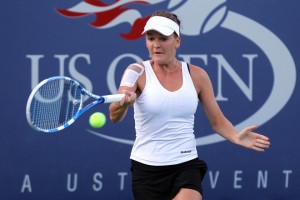By Thomas Swick
swickt@bellsouth.net
After days of wandering I settled into the Grandstand and watched from the warm-ups to the victor’s autograph session with fans. The match, the last of the day (start time 7:30), was between the Polish player Agnieszka Radwanska and the Polish-speaking German Angelique Kerber. And unless you’re a Polish-speaking tennis fan you probably haven’t heard much about it. So let me tell you.

My seat was in the first row, directly behind the German player’s chair. I had been close to the action on the outside courts, but it was different in the stadium, the grandeur of the setting heightening the intimacy of my location. There were about 400 people in attendance, filling only about one-fifth of the seats – the ones closest to the court, which, along with the gathering darkness, further added to the closeness of the moment.
It is amazing what you notice when you sit so near. Halfway through the first set my eyes picked out the stain of pink on the towel covering the seat of Kerber’s chair (replicating the color of the pattern of her skirt). I was struck, after decades of watching tennis, by how many people are employed by the business of two players hitting a ball back and forth. Counting photographers, cameramen, lines people, ball boys and girls, and the umpire in her chair, I came up with 24. And that was just on the court; it didn’t take into account the broadcasters in the booth and the journalists in the media section (most of whom, like a good number of the fans, were speaking Polish).
At such close range, everything looks faster, even the ball boys as they race to retrieve. It occurred to me that the ball boys’ lightning sprint to an inanimate pose is the physical equivalent, in extremes, of the stadium’s transition from raucous applause to respectful hush. During the breaks between sets, after delivering drinks to the players (Evian for the German, Gatorade for the Pole), they quenched their thirst with water from a cooler.
Kerber won the first set; Radwanska the second. Both players became more vocal in the third (or perhaps, after all the visual stimulation, I was just becoming aware of the noise); the Pole accompanying her shots with what sounded like an energetic huff, the German with more of a pained groan.
Before the second game of the set, Radwanska talked loudly to herself in Polish, frustrated with her game but also, perhaps, the fact that she wasn’t taking advantage of what amounted to home court advantage. It was like watching the Championship of Greenpoint, the Polish neighborhood in Brooklyn.
At one of the breaks, more people filed in, just in time to watch a few moon balls. Then, all of a sudden, Kerber was up 5-3, serving for the match. At 40-40, Radwanska hit a listless lob which Kleber put away to get the advantage.
Then an amazing thing happened. The eventual victor netted her first serve – the serve for the match – and no one applauded or even cheered. It was perhaps the most impressive moment in the whole two hours of energetic rallies and killer (mostly Teutonic) lobs. Throughout the match people had vociferously enjoyed the German’s rare failings, but now, at the near climax, no one saw a reason to gloat over her mistake. Nervous tension? Or Polish politeness? As close as I was to it, I couldn’t tell.
